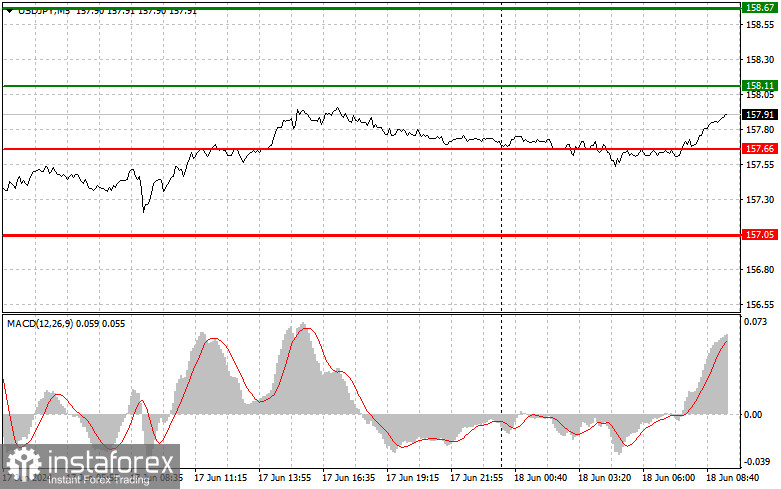Overview of trading and tips on USD/JPY
The price test of 157.72 occurred at a time when the MACD indicator was just starting to move up from the zero mark, which confirmed the entry point to buy the dollar. As a result, the USD/JPY pair rose by more than 25 pips, but we didn't quite reach the target mark.
Despite Bank of Japan Governor Kazuo Ueda leaving the door open for a possible interest rate hike in July, challenging market skepticism about such actions, the Japanese yen did not react to this at all. Last meeting, the governor acknowledged that the central bank will take steps to quantitative tightening by reducing bond purchases.
Given the uncertainty surrounding the dollar's positions, be extremely cautious with long positions near annual highs. It is better to take advantage of the pair's dips rather than trying to gain from breaking local highs. As for the intraday strategy, I will rely more on the implementation of scenario No. 2.
Buy signals
Scenario No. 1. I plan to buy USD/JPY today when the price reaches the entry point at 158.11 plotted by the green line on the chart, aiming for growth to 158.67 plotted by the thicker green line on the chart. In the area of 158.67, I'm going to exit long positions and open short ones in the opposite direction, expecting a movement of 30-35 pips in the opposite direction from that level. You can count on USD/JPY's growth today in continuation of building a bullish market. Before buying, make sure that the MACD indicator is above the zero mark and is just starting to rise from it.
Scenario No. 2. I also plan to buy USD/JPY today in case of two consecutive tests of 157.66 at the time when the MACD indicator is in the oversold area. This will limit the downward potential of the pair and lead to an upward reversal of the market. We can expect growth to the opposite levels of 158.11 and 158.67.
Sell signals

Scenario No. 1. I plan to sell USD/JPY today only after testing the level of 157.66 plotted by the red line on the chart, which will lead to a rapid decline in the price. The key target for sellers will be 157.05, where I am going to exit short positions and also immediately open long ones in the opposite direction, expecting a movement of 20-25 pips in the opposite direction from that level. Pressure on USD/JPY may return in case the price fails to settle near the day's high, but it is unlikely. Before selling, make sure that the MACD indicator is below the zero mark and is just starting to decline from it.
Scenario No. 2. I also plan to sell USD/JPY today in case of two consecutive tests of the price of 158.11 at the time when the MACD indicator is in the overbought area. This will limit the pair's upward potential and lead to a downwards market reversal. We can expect a decline to the opposite levels of 157.66 and 157.05.
What's on the chart:
The thin green line is the entry price at which you can buy the trading instrument.
The thick green line is the price where you can set Take-Profit (TP) or manually fix profits, as further growth above this level is unlikely.
The thin red line is the entry price at which you can sell the trading instrument.
The thick red line is the price where you can set Take-Profit (TP) or manually fix profits, as further decline below this level is unlikely.
MACD line: it is important to be guided by overbought and oversold areas when entering the market
Important: Novice traders in the cryptocurrency market need to be very cautious when making decisions to enter the market. It is best to stay out of the market before important fundamental reports are released to avoid getting caught in sharp price fluctuations. If you decide to trade during news releases, always place stop orders to minimize losses. Without setting stop orders, you can quickly lose your entire deposit, especially if you don't use money management and trade with large volumes.
Remember, for successful trading, it is necessary to have a clear trading plan, similar to the one I presented above. Spontaneously making trading decisions based on the current market situation is inherently a losing strategy for an intraday trader.
 English
English 
 Русский
Русский Bahasa Indonesia
Bahasa Indonesia Bahasa Malay
Bahasa Malay ไทย
ไทย Español
Español Deutsch
Deutsch Български
Български Français
Français Tiếng Việt
Tiếng Việt 中文
中文 বাংলা
বাংলা हिन्दी
हिन्दी Čeština
Čeština Українська
Українська Română
Română


